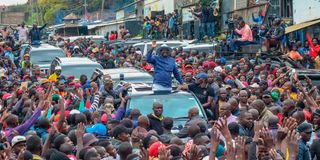Raila grossly misunderstood the 2007 extra-constitutional moment

Azimio la Umoja coalition leaders led by Raila Odinga on their way to Kamukunji grounds in Kibera for a political rally on April 28, 2023.
Last week, I outlined an elaborate argument to demonstrate that the 2022 election and the 2007 crisis are worlds apart by all accounts and further pointed out that the difference matters a great deal.
My aim was to show that Raila Odinga’s campaign of histrionic disruption and equivocal grievance betrays egregious inattentiveness to the historical, socio-political and economic context, exposing Odinga as a political opportunist impelled by reckless delusions, selective amnesia and cynical brinkmanship.
Odinga could only assert the claims he did in 2008 with credibility and a measure of legitimacy under certain conditions, beginning with frayed government legitimacy as a consequence of relentless contestation over a period of five years.
In addition to this, the most critical organisations in the election: the judiciary, police and the electoral commission failed when the stakes were highest.
The post-election crisis, therefore, was the culmination of multiple fundamental failures at the institutional level, and the only way towards the restoration of stability and the institution of a legitimate administration was to facilitate political engagement at the extraconstitutional realm.
It is ironic that Odinga, the central player in this saga, should propound the self-deception that all he had to do in 2007 was challenge the results of the election, mobilise ‘peaceful protests’ and that this sufficed to unlock the extraconstitutional pathway to nusu mkate government. In order to arrive at this stylised proposition, Odinga has to decant a favourable precedent with the most sedulous care, obdurately denying material facts that define the relevant context and distinguish 2007 from every other election.
Reducing the 2007 post-election crisis and the pathway to the Grand Coalition Government to a disputed election and street demonstrations entailed herculean feats of delusion, denial and deception in equal measure. If anything, our current institutional regime, beginning with the constitutional dispensation itself is much more robust than anything in existence in 2007. As a result, Kenya boasts of a fundamental institutional resilience that is essentially a ‘Never Again’ in response to the tectonic tumult of that sad year.
In a manner of speaking, our institutions possess a certain degree of natural immunity, in the sense that they effectively anticipate precisely the sort of civic delinquency and political mischief being perpetrated by Azimio.
Azimio’s supplementary campaign to delegitimise institutions — from the Constitution to IEBC and the Judiciary as well as the National Police Service — and the sensational attempts to profile the country as besieged by intractable crisis are not only futile escapades in pursuance of trenchant propaganda, they fall woefully short of depicting any emergency at all, let alone the sort of constitutional crisis that would justify an extra-constitutional resolution.
Simplistic formula
It is no wonder then, that Odinga finds himself at odds with the international community; his simplistic formula of disputing elections and instigating bedlam in the street as a technology for acquiring power has been exposed.
Moreover, in 2022, Odinga was the de facto incumbent candidate, lavishly sponsored by an administration whose wanton looting, brazen impunity and toxic contempt had stretched the patience of Kenyans beyond tolerance. As a part-time government spokesman and unofficial co-principal of President Kenyatta, Odinga’s legitimacy as a candidate on a progressive platform had spectacularly collapsed.
Furthermore, the Odinga of 2007 is now firmly and finally extinct. A phenomenal mobiliser endowed with prodigious political bandwidth, Odinga’s 2007 edition was simply phenomenal, a veritable force of nature. Today, he is a depleted ambiguous husk, distorted by contradictions and absurd compromises, and inhibited by confounding political debts.
In sum, the Odinga political brand is a victim of Odinga’s own ideological and strategic self-vandalism, who seems more committed to maandamano than he was to his presidential campaign.
Odinga’s impending maandamano are therefore nothing more than a farcical nuisance in an absurd pantomime that has run out of devices and run beyond its allotted time.
The majority of Kenyans observing the current proceedings are keenly aware of the toxic dynamics whose interaction produced the 2007 crisis.
They understand the promulgation of the Constitution in 2010 as a solemn and historic moment when the people committed to turn their backs forever on the tribalism, division, myopia and opportunism that nearly destroyed a nation. It does not help therefore that Azimio’s political platform, derived from the immensely unpopular BBI, is disfigured by a headlong commitment to sinister primordialism.
Odinga was not just present during the 2007 election and the post-election crisis; he was a central figure in the political action before, during and after it.
How is it that he is now pursuing a political formula underpinned by a fundamental misapprehension of the ‘extraconstitutional moment’? What is the basis of his commitment to a shambolic course of action of such quixotic magnitude? Once he realises the futility of it, or tires his fanatical constituency, how will Odinga retire this grossly mistaken sortie?
Mr Ng’eno is an advocate of the High Court.





